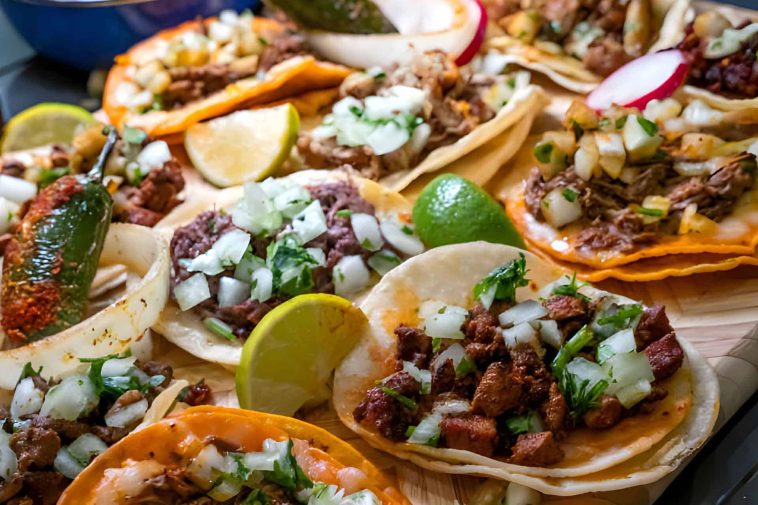Mexican cuisine is a rich tapestry of flavors, each thread representing the diverse cultures and traditions that have shaped it. From the bustling streets of Mexico City to the serene beaches of the Yucatán Peninsula, every region offers its unique twist on classic dishes. Central to this culinary diversity is a commitment to local and sustainable ingredients, which not only enhance the flavors but also pay homage to Mexico’s deep agricultural roots. This guide embarks on a journey through the essentials of modern Mexican cooking, celebrating its vibrant, ever-evolving nature.
Essential Ingredients for Mexican Cooking
The heart of Mexican cooking lies in its ingredients, each bringing a unique flavor and texture to the table:
- Salsa: More than just a condiment, salsa is the soul of many Mexican dishes. Varieties range from the fiery red salsa to the tangy green tomatillo salsa.
- Masa and Masa Harina: These corn-based doughs are fundamental for making tortillas and tamales. Masa harina, a dried form of masa, is widely used for its convenience and consistency.
- Beans: A staple in Mexican cuisine, beans are valued for their versatility and nutrition. Tips for cooking include using dried beans for better texture and experimenting with different varieties.
- Rice: Often cooked with a blend of spices and vegetables, Mexican rice is a colorful and flavorful side dish.
- Herbs/Aromatics: Herbs like cilantro, oregano, and epazote play a significant role in adding depth and authenticity to dishes.
Understanding Flavor in Mexican Cooking
Mexican cuisine is an artful play of flavors, where the balance of salt, acid, and heat is key. Contrary to popular belief, not all Mexican food is inherently spicy. The cuisine is more about achieving a harmonious balance where no single element overpowers another. Chilies offer more than just heat; they contribute a range of flavors from smoky to sweet. Salsas and spices are used not just for their heat but for their ability to elevate a dish, adding layers of complexity. This nuanced understanding of flavors is what makes Mexican cooking both exciting and approachable for cooks of all levels.
Basic Mexican Recipes for Beginners
Embarking on your Mexican cooking journey starts with mastering a few basic recipes:
- Salsas: Begin with simple salsa recipes like salsa verde and pico de gallo. They are easy to make and provide a foundation for understanding flavor combinations.
- Tortillas: Homemade tortillas, whether from masa or masa harina, are a game-changer. They are the perfect canvas for a variety of Mexican dishes.
- Beans: Learn to cook beans from scratch. Start with basic black or pinto beans, simmered slowly with aromatic herbs and spices.
- Rice: Mexican rice, often tinged with tomato and cooked with vegetables, is a staple side dish that complements many meals.
- Guacamole: This popular avocado-based dish is not only delicious but also teaches the importance of fresh ingredients.
Advanced Cooking Techniques
As you delve deeper into Mexican cuisine, you’ll encounter more complex recipes and methods that challenge and excite your culinary skills. Traditional techniques such as mole preparation, which involves roasting and blending various spices, chilies, and ingredients, offer a glimpse into the intricate nature of Mexican cooking. Another advanced technique is the art of making tamales, which requires skill in dough preparation and wrapping. Modern Mexican cooking also embraces innovation, incorporating contemporary methods and global influences while respecting the essence of traditional flavors. Experimenting with sous-vide meats for tacos or adding unconventional ingredients to classic dishes can add a unique twist to your Mexican culinary repertoire. Embracing these advanced techniques not only broadens your cooking skills but also deepens your appreciation for the rich history and complexity of Mexican cuisine.
Pairing and Serving Suggestions
Creating a harmonious Mexican meal involves thoughtful pairing of dishes. A well-rounded meal might include a protein such as pollo asado (grilled chicken), a side of arroz rojo (Mexican red rice), a fresh salsa or guacamole, and hand-made tortillas. Consider the balance of flavors and textures; a spicy main dish pairs well with a milder side to temper the heat. When it comes to presentation, Mexican cuisine is as much about color and vibrancy as it is about flavor. Serve dishes in colorful earthenware or bright plates to enhance the visual appeal. Garnish with fresh herbs or a squeeze of lime to add a final touch of freshness. Remember, the way food is served can be as important as how it tastes in delivering an authentic Mexican dining experience.
Adapting Mexican Cooking to Your Kitchen
Not everyone has access to traditional Mexican ingredients or cooking equipment, but that shouldn’t deter you from exploring this cuisine. Adaptation is key. Substitute ingredients with those available locally while aiming to maintain the original flavor profile. For instance, if epazote isn’t available, cilantro can be a suitable alternative. Similarly, a regular frying pan can be used in place of a comal for tortillas. The essence of Mexican cooking lies in its flavors and techniques, not just in specific ingredients or tools. Embrace the spirit of Mexican cuisine by using what’s available to you while keeping the authentic flavors alive.
FAQs
What are some easy Mexican dishes for beginners?
- Start with tacos, quesadillas, or simple salsas. These dishes are not only easy to make but also allow you to experiment with different flavors and ingredients.
How important are spices in Mexican cooking?
- Spices are crucial in Mexican cuisine as they add depth and complexity to dishes. Common spices include cumin, Mexican oregano, and various chilies.
Can I make Mexican food vegetarian?
- Absolutely! Many Mexican dishes are easily adaptable to a vegetarian diet. Beans, cheese, and vegetables can replace meat in tacos, enchiladas, and more.
What are some tips for cooking authentic Mexican rice?
- Use long-grain rice, fry it lightly before boiling, and add ingredients like tomatoes and peas for flavor and color.
How can I balance flavors in Mexican cooking?
- Balancing flavors involves adjusting the levels of salt, acid (like lime juice), and heat (from chilies) to achieve a harmonious taste.






Comments
Loading…